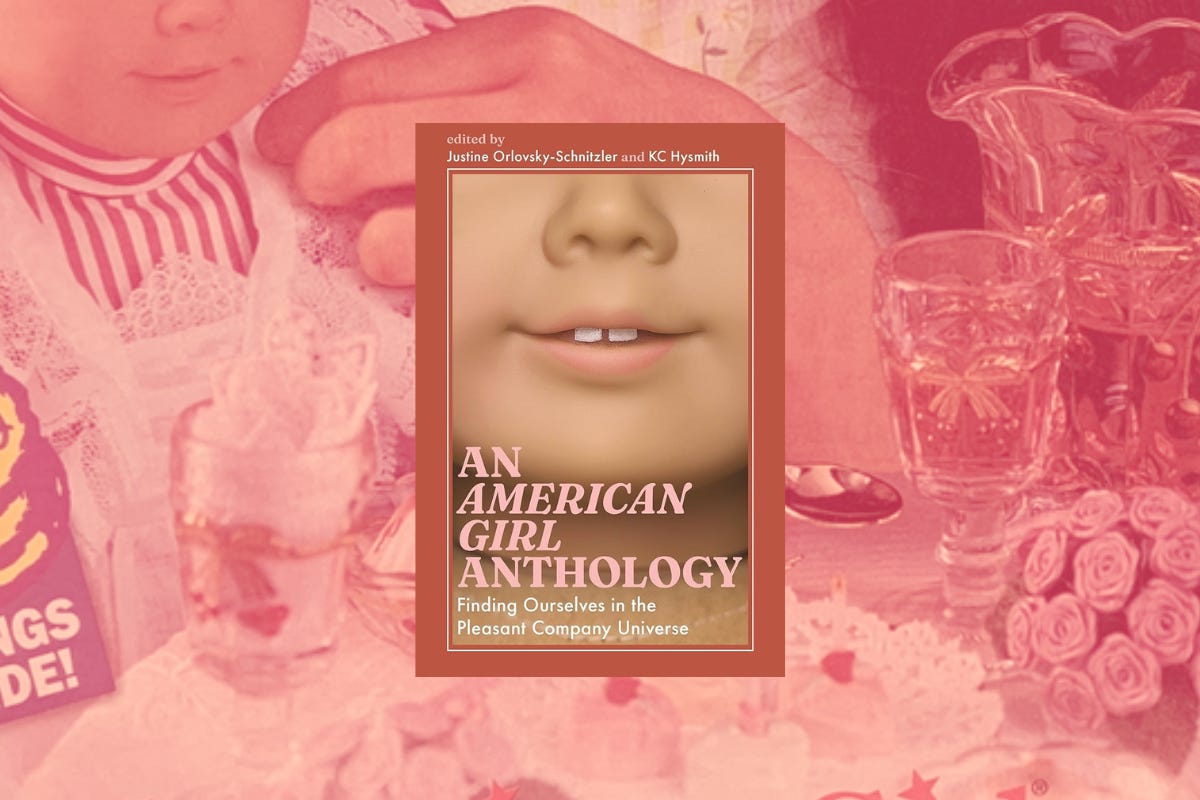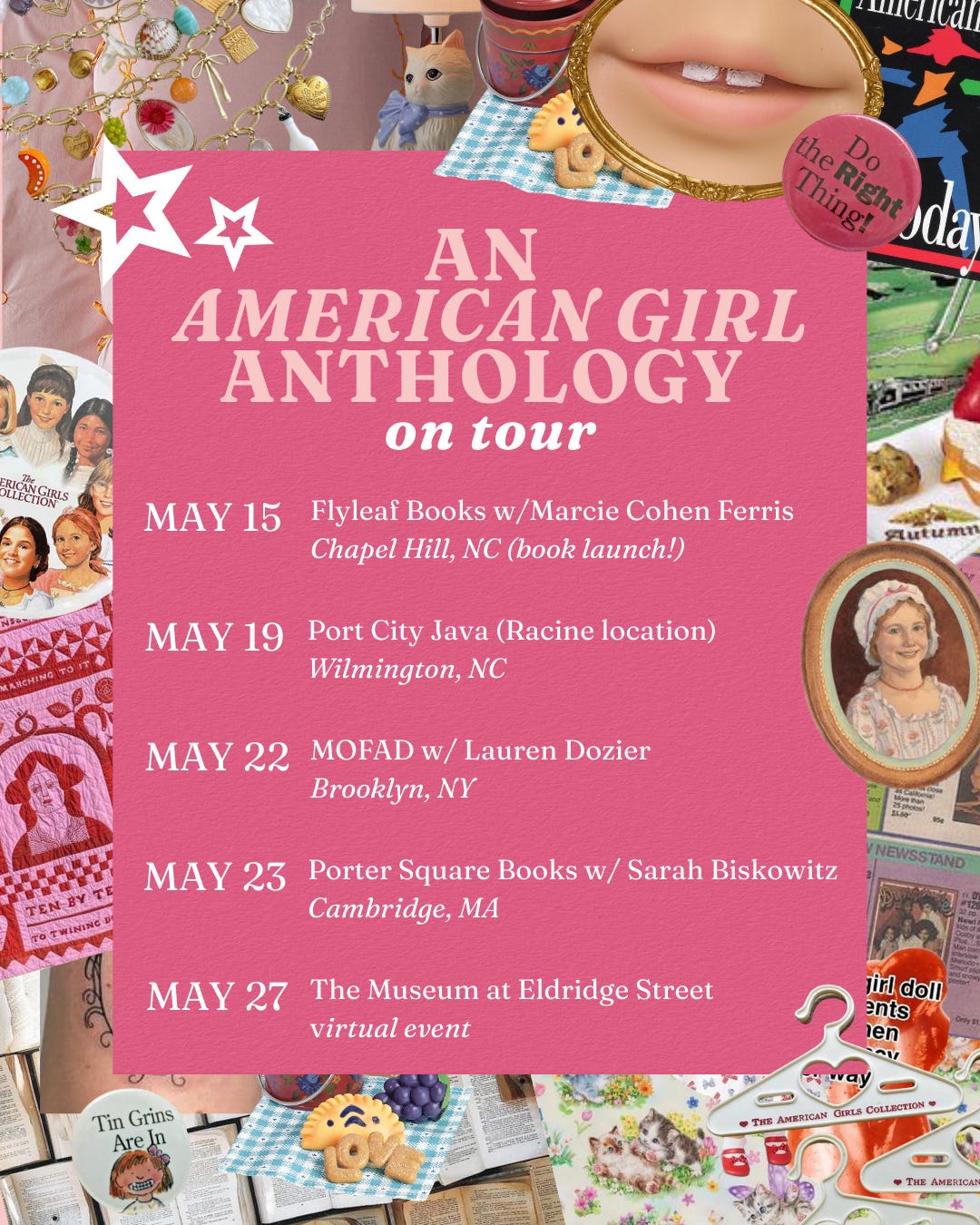Meet An American Girl Anthology
My first not-food book and the food history that helped shape it
This book started, as most other things in my life tend to do, with a cake. In what was perhaps the first instance of a scholarly solicitation in cake form, the buttercream announced, “we need an American girl doll who submits to our call for essays.”
The submissions for An American Girl Anthology bubbled in like a kettle boiling over, emails so rushed with passion and excitement they were riddled with superfluous punctuation, ALL CAPS, and other bits of fervor for a subject so clearly near and dear to so many hearts. Sadly, books are burdened with page lengths and we were forced to pick and choose amongst the many wonderful, brilliant, witty, and wise words sent our way.
My co-editor Justine and I intended to write chapters, too, along with the other beginning and end bits of the book. As we opened each new submission, I selfishly worried that someone else might want to write about American Girl food: the historical cookbooks, the tiny plastic lunches that accompanied each doll, or the story lines studded with food mentions. But no one did. Well, no one except for my eventual co-author and fellow food scholar Esther Martin, who emailed me in a panic about the importance of Felicity’s 18th-century breakfast puffs, which is how my first not-food book, managed to have a bit of food tucked in, too.
It has been so easy to hype up each of the wonderful essays in this anthology, but—to be a bit vulnerable—I’ve struggled with how to talk about the book in my traditional spaces because it’s not exclusively about food and food is what I do. I think, perhaps, the struggle is really a case of bewilderment, because to me (and Esther) American Girl has always and was only ever really about the food.
Esther’s oldest memory of historical cooking is what she believes is the first cookbook she ever owned: American Girls Pastimes Felicity’s Cook Book. Felicity and the other American Girls began Esther’s obsession with historical costume, crafts, and, of course, food. The use of the word “historical” in this context is intentionally flippant, keeping in mind that all the information gathered from the AG books was filtered through the lens of a major toy corporation. Looking critically at the cookbook now, we can see plenty of plot holes: missing information about the time period, glossing over less pleasant aspects about food and food-related labor, and information that is pure fabrication. Esther still uses Felicity’s Cookbook for using up leftover rotisserie chicken in the eighteenth-century recipe for chicken pudding and whipping up breakfast puffs (essentially Yorkshire puddings). She even keeps a bottle of rosewater on hand “just in case” she needs to make Felicity’s queen cakes, like those served at her American Girl doll-themed ninth birthday party. Esther’s obsession led her to acquire all of the Pleasant Company historical cookbooks, including the later published Cooking Studio books complete with cooking accessories such as cookie cutters and reusable place cards. She also now has the context to see and analyze the gaps these books all contain when it comes to using food history as a lens to understanding the construction of American culture and identity.
KC never owned anything related to American Girl as a child, but eagerly ate up the long row of books at the library, eventually finding the historical cookbooks much to her mother’s chagrin. She remembers begging for ingredients to make Samantha Parkington’s Lemon Ice, a recipe from the nineteenth-century, despite her mother’s insistence that it would melt almost instantly in the Texas heat. Early in her childhood, KC lived on a ranch in central Texas and helped her dad (the ranch hand) with various chores including milking cows, feeding sheep, and tending to a large wood-burning stove in the dining room. Skimming thick cream off the top of a fresh pint of milk and the cast iron skillets that her parents used to cook reminded her of the ingredients and cooking techniques frequently used in the historical AG cookbooks. This early connection to food initially guided KC towards culinary school, but a last-minute decision redirected her to studying food instead and finding the connections between historical recipes and our contemporary approaches to food.
An excerpt from “‘Eating breakfast like it’s 1774’: American Girl Cookbooks, Gender, and Identity-Making Through Food History” by KC Hysmith and Esther Martin
While neither of us could likely articulate it as such as children, Esther and I only really engaged with the AG universe because of the food history. It didn’t matter if Samantha’s posh lemon ice was a brief mention in a single book or if Felicity’s breakfast puffs should have actually been called “popovers” in late 18th century colonial America—American Girl was for food history lovers and we were in love.
As An American Girl Anthology contributor Tara Strauch explains in her essay “Teaching Girl(’)s History: American Girls, Curricular Standards, and Historians,” we were a part of the “Felicity Generation,” a term used to describe a subset of scholars (and other adults) who “absorbed social history through the American Girl stories as well as K-12 curriculum that began to reflect social historian’s research by the 1990s.” We fell for the food, but others found connection with countless other aspects of the American Girl universe—aspects that helped us navigate the sociocultural particulars of our favorite American Girl characters, as well as the broader strokes of a society we read about in actual history books and experienced everyday in our own lives.
American Girl has had plenty of missed connections, too, regarding issues of identity, erasure, representation, and inclusion—issues contributors cover throughout the anthology. While I’m push-up-the-bridge-of-my-glasses-proud to say that there are food-related examples touching on most of those big complex topics in the AG universe, there’s also compelling examples in the molds used to shape the dolls’ faces, the language used in the classic non-fictional AG branded texts such as Oops! The Manners Guide for Girls and The Care and Keeping of You, and the countless self-actualizing memes filled with the American Girls we probably needed back then if not definitely right now.
We are so excited to celebrate all of these connections as well as the thoughtful critique of the missed connections, too, with the launch of An American Girl Anthology (out today everywhere and available at your favorite local book seller!). And while I no longer struggle with the fact that the entire book isn’t focused solely on food, I am particularly delighted that we will be marking its debut today with another special cake.
At our forthcoming book tour stops, we’ll talk about all of these unique connections and missed connections found in the American Girl Universe. For my fellow food and culture fans, there will be a special food history focus during our MOFAD (Museum of Food and Drink) event plus a make your own American Girl historical recipe writing activity featuring these special An American Girl Anthology recipe cards. If you’re not in New York or can’t make the event, feel free to print out your own recipe card and start your own American Girl historical recipe collection!










As a ‘90s girl who absolutely devoured every historical fiction stories and of course was AG obsessed I can’t believe I’m just now finding out there were companion cook books! Sad for my 7 yr old self. She’d have loved those.
The miniature food and food implements were definitely my biggest draw as a kid! I loved imagining I was enjoying the foods described in the stories. Looking forward to reading the book!